Photo Gallery #2
© Copyright 2022, R. Fleischer
https://bmwmotorcycletech.info/photogallery2.htm
BMW M2 B15 engine.
This is not a propeller for an airplane. This "propeller" is what is called a "Club", & has other names. Its purpose is to act as a proper load on the engine, simulating the loading effects of a proper propeller. Usually these are designed to be much shorter than they would be on an airplane.

| BMW supplied this boxer engine for airplanes, especially for the Victoria & later the Helios motorcycles. The Bison also used this engine. For Information on the airplane engine for other makes: http://en.wikipedia.org/wiki/BMW_M2B15.
The engine was a 1920/1921 development, & produced for a long time. For a complete history of the Roundel, & of BMW, & more information on this engine, see: https://bmwmotorcycletech.info/roundel.htm It was this type of engine that Max Friz modified & used in the first BMW motorcycle, the R32, first shown to the public in September 1923, where it was a sensation. Friz finished his life-size drawings in late 1922. His design included a clutch, 3 speed gearbox & shaft drive. There were over 100 German companies making motorcycles, the acceptance was quite a feat for BMW. The R32 was introduced at a time of hyper-inflation in Germany; priced rather high, yet it sold well. The R32 was built to last, get good fuel mileage, & looked stunning. Displacement was 494 cc, horsepower 8.5 at 3300 RPM; under 300 pounds. It would do 53 mph. About 3000 were built & sold.
Note that the original version of the engine as used by Victoria, etc., was said to have ~6.5 hp. It is not clear to me if that was true or a typographical error. |
| (Ian's viewpoint, verbatim:) Ian Falloon: For nearly 100 years BMW has produced singles, twins, triples, fours and sixes but the enduring layout has been the boxer twin with shaft final drive. This has become the trademark that defines the BMW motorcycle and it all began in 1923 with the R32. The R32 evolved from BMW’s existing M2 B15 (2 for two cylinders and B for boxer) but as the rear cylinder tended to overheat on the M2 B15-powered Victoria and Helios, designer Max Friz decided to mount the engine transversely and adding a shaft final drive, and Friz had the drawings completed by December 1922. Although the 1919 English Sopwith ABC motorcycle also featured a transverse twin-cylinder engine (without shaft drive), Friz claimed he was unaware of the ABC at the time. ABC’s designer Granville Bradshaw later accused BMW of copying the ABC, but there were too many detail differences for this to be substantiated. The R32 68x68mm side-valve engine had a low 5:1 compression ratio and with a single 22mm BMW Special carburettor produced a moderate 8.5 horsepower at 3,200rpm. This was slightly more than the M2 B15, but while the power output didn’t set the world alight, the R32’s design and execution was ground breaking. Concentrating on reliability and ease of maintenance, the engine, including the valve timing system, was fully encased. Due to the shaft final drive and inline crankshaft there were no chains requiring adjustment so compared to other 500s the R32 was revolutionary. A hand lever operated the three-speed grease-filled gearbox, and the ignition was by a magneto generator via a rather complicated set of handlebar controls. Friz installed this engine in a closed twin-loop tubular steel frame, with the fuel tank underneath the upper frame tubes. The frame was brazed and sleeved, but as the workers lacked experience in brazing, fractures on the solder joints were a problem until the introduction of pressed steel frames in 1929. The front suspension consisted of a short swinging fork with a cantilever plate spring beneath the steering stem. The rigid frame meant the driveshaft didn’t require a universal joint, with a rubber disc a sufficient shock absorber, Initially the only brake was a rear wheel block type operated by the rider’s heel, but by 1925, a front 150mm drum brake was introduced. The R32 (R for Rad meaning wheel but the 32 remains a mystery) was also surprisingly light at 122kg and offered a top speed of around 90 km/h. The low centre of gravity, short 1,380mm wheelbase and 26-inch wheels promised safe and manageable handling for a touring motorcycle on the poor quality roads of the day. In May 1923, Friz himself tested the R32, finishing the “Fahrt durch Bayerns Berge” trial through the Bavarian mountains without incurring any penalties. The R32 was launched at Berlin in September 1923, one month before the Paris Car Show where it was a star attraction, establishing BMW’s boxer-twin shaft-drive format. Despite its impressive credentials the initial response to the R32 was mixed. Sceptics feared the engine could be easily damaged in a fall, others felt it underpowered, but no one could deny the compact engine and transmission unit was a brilliant design and beautifully executed.As cars were for the wealthy few the motorcycle market flourished in Germany during the early 1920s, BMW managing to sell 1,500 R32s by the end of 1924, with sales totalling 3,090 by the time production finished in 1926. Most were sold in Germany and it is estimated only around 60 survive today. Despite its modest specification the R32 was the founder of the species and holds a special place in BMW’s history, serious collectors considering it the most desirable BMW motorcycle. |
Below is a photo of the extremely rare Victoria KR1. This photo is of the un-restored bike in Peter Nettesheim's collection in Long island, N.Y. This motorcycle model was introduced ...I think...in 1920...but I am not sure what the original first model(s) engine was. However, the BMW engine was the one on later versions, as shown here. This motorcycle has a 2-speed transmission. I do not know the year of this particular bike. NOTE the direction of the cylinders, fore & aft, a potential problem with overheating. Victoria was a bicycle maker in Nurnberg, Germany, that made various motorcycles up to the mid-sixties. This Victoria company had nothing to do with the Victoria company of Scotland.
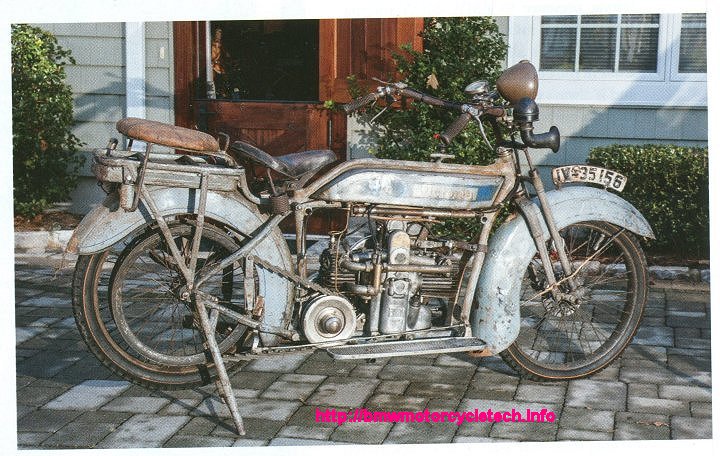
Below are three photos of a nicely restored Victoria. These photos came, I believe, from photos in BMWRA's OTL magazine. More complete photos were not in OTL. I'd love to find more photos of different angles. I think photos may be available from Vetch.
Below is a photo of the Victoria KR1 that "Vetch" restored...LOVERLY!
Compare very carefully to the above Victoria, there ARE differences!
In fact, there are differences between it and the unrestored one in Nettesheim's collection.
NICE JOB, Vetch! I'd give almost anything to own one.
Below is a cutaway view for the R32 engine & gearbox for motorcycle use. Note the changes to the engine to accommodate the gearbox, etc., because the engine was originally used for such as airplanes, ...and even industrial use.
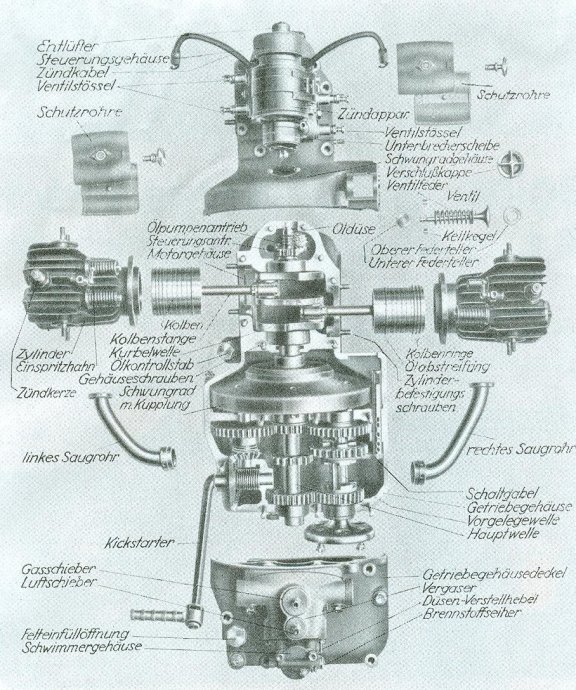
Note, again, that the R32 had the cylinders in the classic cross-wise installation which we all recognize, as opposed (sorry, bad pun!) to the installation in the Victoria motorcycle.
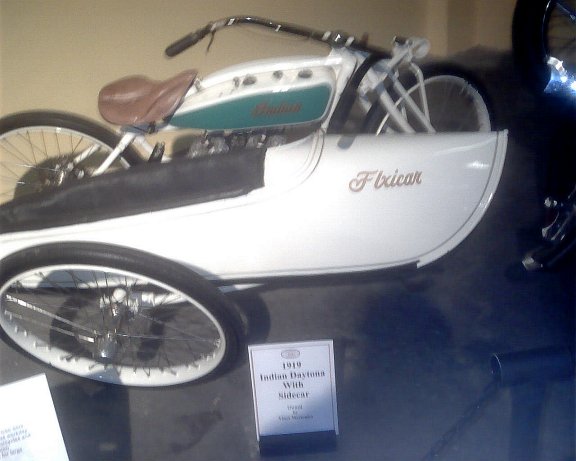
Re: this Flxicar:
John Goff informed me that the patent for Hugo Young's design is readily available, complete with drawings. The design worked, but from an modern day engineering point of view, its function had issues. The nature of the tilting wheel design meant that the sidecar body "dipped" in the lean. If you were to compare it to a modern unison leaner & the Armec Sidewinder, the Flxi Flyer is another half-step in-between in terms of design.
For LOTS more on more modern "leaners", where at least the bike leans in turns, and how to contact John Goff, an authority & historian on leaner sidecar rigs, see: https://bmwmotorcycletech.info/flexit.htm
Here is the patent:
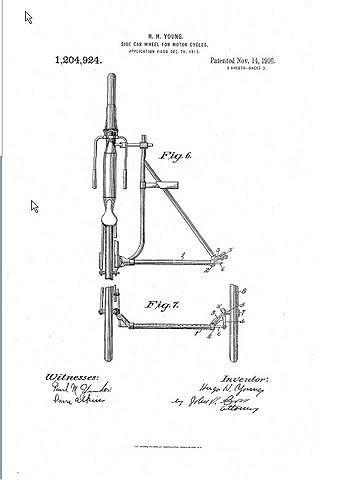
Smith motorized bicycle:

I had two brand-new early Triumphs. My first one was purchased brand-new in 1956, it was a TR6. I used this bike for both street and dirt riding.

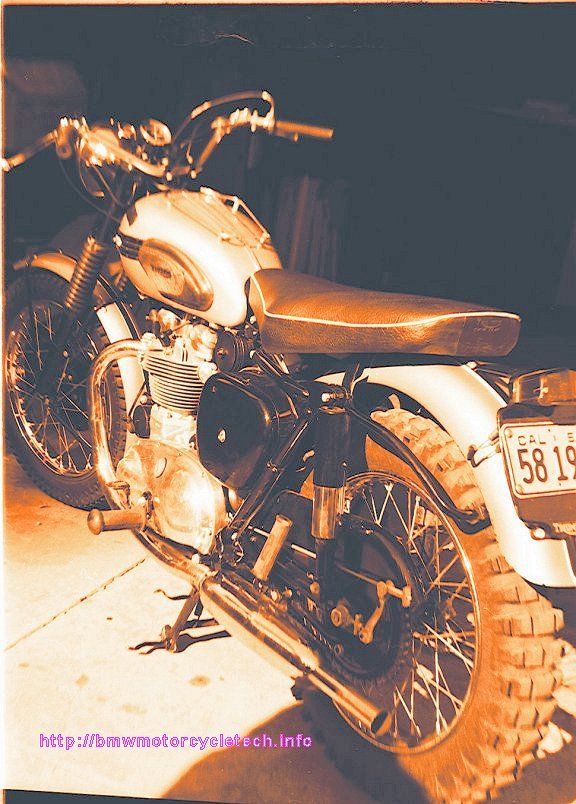
Photo was taken by a friend, this was my first GP bike race, the Catalina Grand Prix, 1957.
Blasting through Avalon, on the way to the twists and turns of the back of the Island.
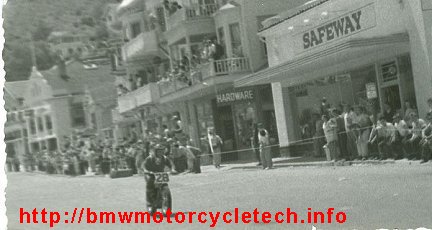
View from the ski slopes at Heavenly Valley, Lake Tahoe:
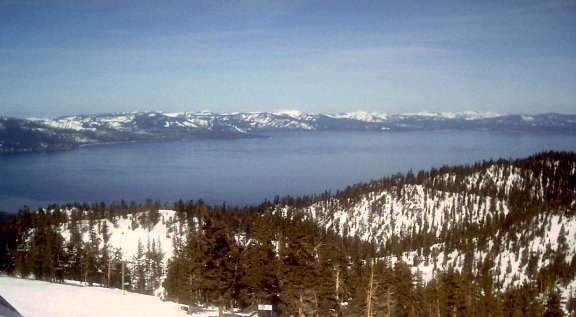

Me, ready for a run down Ellie's. Ellie's was my favorite run at Heavenly Valley Ski Resort (which was only a handful of miles from my Lake Tahoe home). Ellie's has most types of skiing, including moguls (bumps...), steeps, often some powder at the top ...and too darn often very icy at the top (and, moguls a-plenty). Plenty of narrows, whoop-de-do's, etc. For tree skiing you do have to go off-piste; and several big bowl areas are not far away. What you see, above, is me on the flat area at the very top, with the beginning of the steep entrance to Ellies to the left side of the photo. Below is a view from a few feet further left. Yes, it is pretty steep, and yes, those are moguls, if somewhat washed-out by the glare in the photo.

Below are photos of my first 'hot-rod'. This started off life as the lightest Ford, a 1949 Business Coupe. I gutted it.
The engine I extensively modified began as a 49 Ford Flathead V-8. I installed a longer-stroke Ford Mercury crankshaft, a special cam, Navarro head, Joe Hunt Scintilla Vertex special magneto, and the water-warmed supercharger (worm drive type) that you can clearly see here.
There were extensive modifications, and I made many parts myself. I did all the work under the tutelage of Arthur "Art" Gerrick. For the times, this was a very fast street car. It produced ~300 dyno horsepower. After a few years I decided to cut the car up into pieces & dispose of it (really did that, cheaper than taking the frame, body, etc., to the dump).
I then installed the engine into a 1952 M-TD, with numerous modifications to make it fit. That car could raise its nose like a dragster, with the pedal to the metal. When I sold the MG-TD it had the same engine & same supercharger, but with a Norden single low pressure fuel injector I was testing. I had purchased ALL of the last of the Norden items, hundreds of parts, castings, etc, including original unmachined castings, at a sale. One additional item that would have been nice on the MG was on the Ford, to avoid axle destroying problems. I obtained a 1-3/8" wide gears "Indianapolis" rear end center section free from a friend, Vic Edelbrock (yes, one and the same Edelbrock, a friend of mine back then), & with big thick axles, there would have been no more twisted off MG axle problems. I knew rather well Vic & many other famous rodders, many of whom opened businesses, way back then. The MG-TD had 16" wheels & tires, faired-in running boards, a 32 Ford radiator shell (cut down & narrowed), & faired-in but otherwise stock rear gas tank. The dash was homemade, & had mostly aircraft instruments. I was off to Service the Service, & decided to get rid of most all my projects. The below photos are almost all I have left of the Ford car, I have no photos of the MG-TD. To this day I greatly regret not keeping the 'build' photos of the MG-TD; these all went to the new owner. An eagle eye here will reveal aircraft fittings, courtesy of buy-by-the-pound at Douglas Aircraft Company's surplus store, located 3 miles or so from my house. I made many of the metal parts for this car & engine. Some are very visible here. A VERY sharp eye on the second below photo will tell you that those cross-slotted screws on the carburetor intake horns are NOT Phillips, but Reed & Prince aircraft screws.
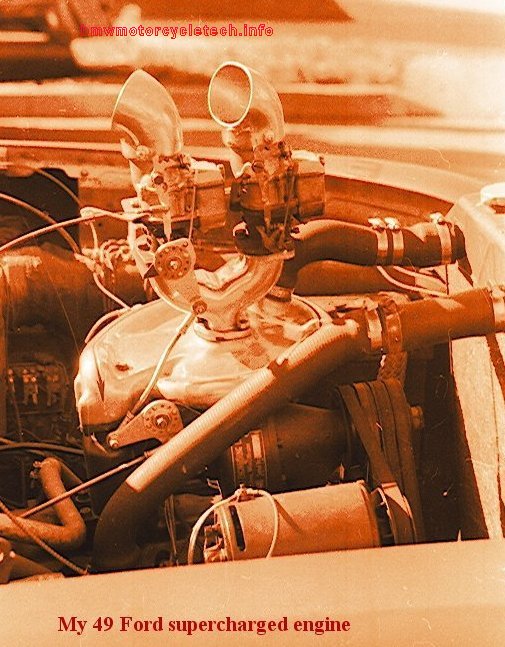

PRE-modifications:

Another Ford/Merc flathead engine:
Below is another of my vehicles, a 32 Ford pickup.
My 29 Ford A sport coupe is in another Gallery.
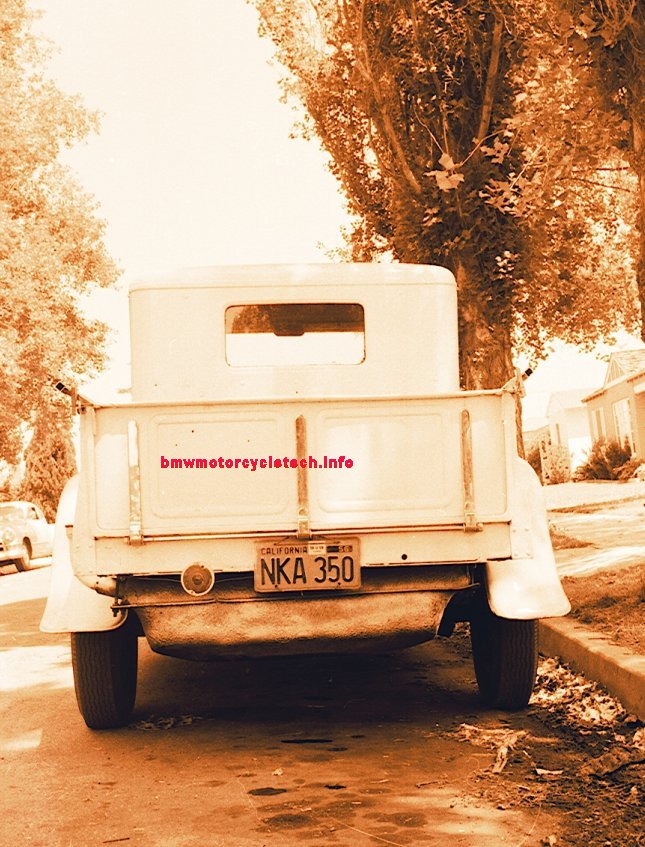

Some say I am as old as the hills. As proof, I offer this photo of the unpaved Echo Summit road which you may know as Highway 50, going into the Tahoe Valley area from Sacramento. Unfortunately, I do not have one showing horse-drawn wagon trains on this particular road. That white pickup looks familiar.
rev:
02/11/2014: Add a bit more information about the BMW engine; correct a typo on model #.
04/17/2015: Add more photos of the Victoria.
08/09/2015: Move the 'table' that holds the info on the BMW, below the aircraft engine, to the left side. Add information: 3 speeds, and HP was at 3300.
08/14/2015: Add the Echo Summit photo and commentary.
10/01/2016: Clean up code.
03/23/2018: Fix layout, fonts, colors, over-all appearance. Reduce excessive html.
04/05/2018: Insert photo of Vetch's Victoria KR1; by permission, and with text as agreed-upon.
03/14/2019: Add video link and commentary at top of article.
02/06/2020: Remove Benz info, etc., move to technical articles list page.
08/31/2020: Expand comments.
03/08/2022: Add Ian's comments, and clean up hidden code.
© Copyright 2023, R. Fleischer
For Photo Gallery #3: photogallery3.htm
Return to Technical Articles LIST Page
Last check/edit: Friday, August 18, 2023